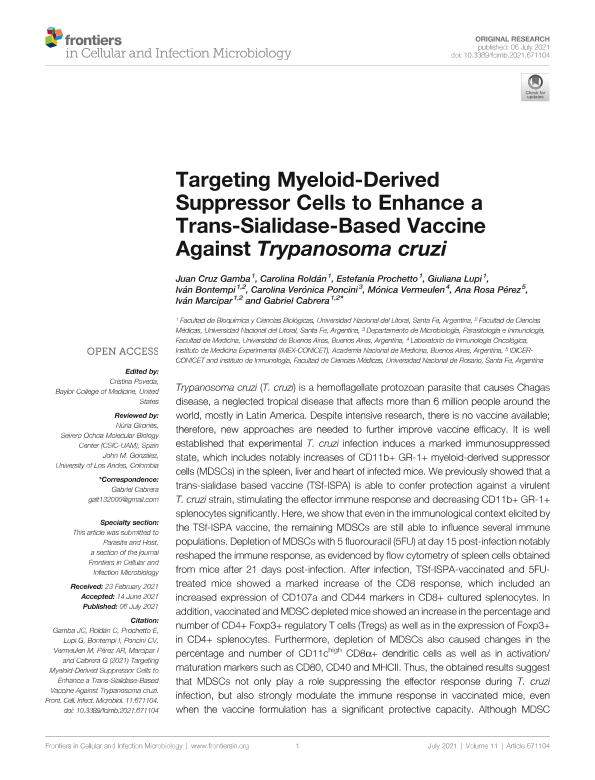Artículo
Targeting Myeloid-Derived Suppressor Cells to Enhance a Trans-Sialidase-Based Vaccine Against Trypanosoma cruzi
Gamba, Juan Cruz; Roldán, Carolina; Prochetto, Estefanía Soledad ; Lupi, Giuliana Antonella
; Lupi, Giuliana Antonella ; Bontempi, Iván
; Bontempi, Iván ; Poncini, Carolina Verónica; Vermeulen, Mónica; Perez, Ana Rosasanta fe; Marcipar, Iván Sergio
; Poncini, Carolina Verónica; Vermeulen, Mónica; Perez, Ana Rosasanta fe; Marcipar, Iván Sergio ; Cabrera, Gabriel Gustavo
; Cabrera, Gabriel Gustavo
 ; Lupi, Giuliana Antonella
; Lupi, Giuliana Antonella ; Bontempi, Iván
; Bontempi, Iván ; Poncini, Carolina Verónica; Vermeulen, Mónica; Perez, Ana Rosasanta fe; Marcipar, Iván Sergio
; Poncini, Carolina Verónica; Vermeulen, Mónica; Perez, Ana Rosasanta fe; Marcipar, Iván Sergio ; Cabrera, Gabriel Gustavo
; Cabrera, Gabriel Gustavo
Fecha de publicación:
07/2021
Editorial:
Frontiers Media
Revista:
Frontiers in Cellular and Infection Microbiology
ISSN:
2235-2988
Idioma:
Inglés
Tipo de recurso:
Artículo publicado
Clasificación temática:
Resumen
Trypanosoma cruzi (T. cruzi) is a hemoflagellate protozoan parasite that causes Chagas disease, a neglected tropical disease that affects more than 6 million people around the world, mostly in Latin America. Despite intensive research, there is no vaccine available; therefore, new approaches are needed to further improve vaccine efficacy. It is well established that experimental T. cruzi infection induces a marked immunosuppressed state, which includes notably increases of CD11b+ GR-1+ myeloid-derived suppressor cells (MDSCs) in the spleen, liver and heart of infected mice. We previously showed that a trans-sialidase based vaccine (TSf-ISPA) is able to confer protection against a virulent T. cruzi strain, stimulating the effector immune response and decreasing CD11b+ GR-1+ splenocytes significantly. Here, we show that even in the immunological context elicited by the TSf-ISPA vaccine, the remaining MDSCs are still able to influence several immune populations. Depletion of MDSCs with 5 fluorouracil (5FU) at day 15 post-infection notably reshaped the immune response, as evidenced by flow cytometry of spleen cells obtained from mice after 21 days post-infection. After infection, TSf-ISPA-vaccinated and 5FU-treated mice showed a marked increase of the CD8 response, which included an increased expression of CD107a and CD44 markers in CD8+ cultured splenocytes. In addition, vaccinated and MDSC depleted mice showed an increase in the percentage and number of CD4+ Foxp3+ regulatory T cells (Tregs) as well as in the expression of Foxp3+ in CD4+ splenocytes. Furthermore, depletion of MDSCs also caused changes in the percentage and number of CD11chigh CD8α+ dendritic cells as well as in activation/maturation markers such as CD80, CD40 and MHCII. Thus, the obtained results suggest that MDSCs not only play a role suppressing the effector response during T. cruzi infection, but also strongly modulate the immune response in vaccinated mice, even when the vaccine formulation has a significant protective capacity. Although MDSC depletion at day 15 post-infection did not ameliorated survival or parasitemia levels, depletion of MDSCs during the first week of infection caused a beneficial trend in parasitemia and mice survival of vaccinated mice, supporting the possibility to target MDSCs from different approaches to enhance vaccine efficacy. Finally, since we previously showed that TSf-ISPA immunization causes a slight but significant increase of CD11b+ GR-1+ splenocytes, here we also targeted those cells at the stage of immunization, prior to T. cruzi challenge. Notably, 5FU administration before each dose of TSf-ISPA vaccine was able to significantly ameliorate survival and decrease parasitemia levels of TSf-ISPA-vaccinated and infected mice. Overall, this work supports that targeting MDSCs may be a valuable tool during vaccine design against T. cruzi, and likely for other pathologies that are characterized by the subversion of the immune system.
Archivos asociados
Licencia
Identificadores
Colecciones
Articulos(CCT - SANTA FE)
Articulos de CTRO.CIENTIFICO TECNOL.CONICET - SANTA FE
Articulos de CTRO.CIENTIFICO TECNOL.CONICET - SANTA FE
Articulos(IDICER)
Articulos de INSTITUTO DE INMUNOLOGIA CLINICA Y EXPERIMENTAL DE ROSARIO
Articulos de INSTITUTO DE INMUNOLOGIA CLINICA Y EXPERIMENTAL DE ROSARIO
Articulos(IMEX)
Articulos de INST.DE MEDICINA EXPERIMENTAL
Articulos de INST.DE MEDICINA EXPERIMENTAL
Citación
Gamba, Juan Cruz; Roldán, Carolina; Prochetto, Estefanía Soledad; Lupi, Giuliana Antonella; Bontempi, Iván; et al.; Targeting Myeloid-Derived Suppressor Cells to Enhance a Trans-Sialidase-Based Vaccine Against Trypanosoma cruzi; Frontiers Media; Frontiers in Cellular and Infection Microbiology; 11; 7-2021; 1-16
Compartir
Altmétricas



